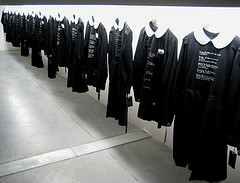Archive for the ‘New Thinking’ Category
Do Magical Work
 We are responsible for our actions, for what we do, for our work, and others are responsible for their response to it. (That’s why they call it responsibility.) Though we know we can’t control others, we still snare ourselves in worry trap: What will they think? Will they like it? What will they say?
We are responsible for our actions, for what we do, for our work, and others are responsible for their response to it. (That’s why they call it responsibility.) Though we know we can’t control others, we still snare ourselves in worry trap: What will they think? Will they like it? What will they say?
Worse than the worry trap, however, is when we actually change our work based on what others will think. A big no-no. We’re asked to do the work because we’re talented, we’re uniquely qualified, we’re the experts. Why do we let opinions of others wield so much power? Who cares what they say. We will let our work speak for itself.
There’s not much in life we have control over, but work is one of them. We control most everything about it: the what and how, the caliber, the tenor. We choose to do marginal work, average work, great work, or magical work. It’s our choice. We choose. When we chose to do magical work, its voice powerful enough to drown out the less capable, the politically motivated, and the CEO.
So go do magical work. Do work so good you don’t remember how you did it, so good you don’t think you could do it again, so good it scares you. But be ready – magical work, by definition, is misunderstood.
What will they say about your magic? It doesn’t matter, magic’s voice will drown them out.
Doing New
 Doing new is hard and starting new is particularly hard. Once fear is overcome and new is started, doing new becomes a battle with discouragement. Not managed, discouragement can stop new.
Doing new is hard and starting new is particularly hard. Once fear is overcome and new is started, doing new becomes a battle with discouragement. Not managed, discouragement can stop new.
Slumped shoulders and a head hung low are the signs and a mismatch with expectations is the source. Expectations are defined in the form of a project plan, but, since the work is new, expectations are not grounded, not calibrated. How long will it take to do something we’ve never dreamed of doing? Yet when disguised as a project plan, uncalibrated expectations become a hard deadline.
When you want to do new, you give the project to your best. When they use the right tools, the latest data, and the best processes, yet new does not come per the plan, your best can become discouraged. But this discouragement is misplaced. Sure, the outcome is different from the plan, but reality isn’t the problem, it’s the plan, the expectations. They did everything right, so tell them. Tell them the expectations are out of line. Tell them you think their doing a good job. Tell them if it was easy, you’d have given the project to someone else. Tell them they can feel discouraged for five more minutes, but then they’ve got to go back, look new in the eye, and kick its ass.
Green Jeans Drive Innovation
 Environmental stability, aka, Green, is just starting. Most are still in reluctant compliance mode, hoping beyond hope that this newest of corporate initiatives dies on the vine, that it’s just another corporate initiative. Wrong. Very wrong. It’s the way we’re going to grow our business; it’s the way we’re going to make money. It’s time to open our minds, grab Green by the throat, and shake it. Green is here to stay, and Green will demand we change our thinking, will make us see our problems differently, will require we dismantle our intellectual inertia, will require innovation.
Environmental stability, aka, Green, is just starting. Most are still in reluctant compliance mode, hoping beyond hope that this newest of corporate initiatives dies on the vine, that it’s just another corporate initiative. Wrong. Very wrong. It’s the way we’re going to grow our business; it’s the way we’re going to make money. It’s time to open our minds, grab Green by the throat, and shake it. Green is here to stay, and Green will demand we change our thinking, will make us see our problems differently, will require we dismantle our intellectual inertia, will require innovation.
Pretend you’re a manufacturer of jeans, the blue ones, the ones that feel so good when you put them on, the ones you’d like to wear to work if you could. (Maybe that’s just me.) Year-on-year your innovation efforts focus on adding pockets then removing them, adding holes then removing them, zippers here then there, dark wash then light, baggy then tight, and yellow stitching than red. What else can a jean innovator do?
Corporate sends the memo: “We’re going Green.” Green jeans. They hire the best sustainability consultants and you, the jean innovator, sit through the sustainability audit results. Their recommendation – reduce carbon footprint: use materials that consume less energy, reduce electricity in your factories, minimize distribution’s fuel costs, and reduce travel miles of your sales folks. Brilliant. Whatever we paid these guys, it was too much. But then they twist your brain. The carbon footprint from the use of your product dwarfs everything else. Your customers generate a massive carbon footprint when they wash and dry your jeans, and you have no control over it. Your jeans are made once and washed and dried countless times. Whoa. Your eyes roll back in your head. What’s a jean innovator to do? First thing – forget about the stupid pockets. Next, figure out how to reduce the carbon footprint generated by your customers. Define the problem and innovate. But what’s the problem?
Why do folks wash their jeans? The obvious answer – they’re dirty. Let’s figure a way to prevent jeans from getting dirty, right? No. The real answer – they stretch, they get baggy and don’t fit right; so we wash them to tighten things up. We wash CLEAN jeans because they get baggy, not because they’re dirty. Let’s fix that.
Believe it or not, there are many likely innovative solutions to make jeans de-baggy themselves, but that’s not the point. The point is we must innovate on jeans that reconfigure, and must not innovate on keeping jeans clean (though we may innovate on that down the road) and must not innovate on pockets, zippers, and stitching.
Green shaped our innovation work. We now have Green jeans that feel good and spring back after wearing and fit great on day two – no washing required. We now have Green jeans that save customers time and money while flattering their backside. But here’s the point – we would have never invented de-baggying jeans without opening our minds to Green as a way to grow our business, to Green as a way to make money. Reluctant compliance won’t get us there. Grab Green by the throat and shake it…before your competitors do.
The Emotional Constraint
 “Constraint” is most often an excuse rather than a constraint. In fact, there are very few true constraints, with most of them living in the domain of physics.
“Constraint” is most often an excuse rather than a constraint. In fact, there are very few true constraints, with most of them living in the domain of physics.
A constraint is when something cannot be done. It’s not when something is difficult, complex, or unknown. And, it’s not when the options are costly, big, or ugly. There are no options with a true constraint. Nothing you can do.
The Physical Constraint
If your new product requires one of its moving parts to go faster than the speed of light, that’s a physical constraint (and not a good idea). If your new technology requires a material that’s stronger than the strongest on record, that’s a constraint (and, also, not a good idea). If your new manufacturing process consumes more water than your continent can spare, that’s a constraint. (This may not be a true constraint in the physics sense, but it’s damn close.) Don’t try to overpower the physical constraint – you can’t beat Mother Nature. The best you can do is wrestle her to a tie, then, when you tire, she pins you.
The Legal Constraint
If your approach violates a law, that’s a legal constraint. Not a true constraint in a physical sense, as there are options. You can change your approach so the law is not violated (maybe to a more costly approach), you can lobby for a law change (may take a while, but it’s an option), or you can break the law and roll the dice. To be clear, I don’t recommend this, just wanted to point out that there are options. Options exist when something is not a constraint, though the consequences can be most undesirable, severe, and may not fit with who we are.
The Emotional Constraint
If a person in power self-declares something as a constraint, decides there are no options, that’s an emotional constraint. Not a true constraint in a physical sense, but it’s the most dangerous of the triad. When there is no balance in the balance of power, or the consequences of pushing are severe, the self-declared emotional constraint stands – there are no options. Like with the speed of light, where adding energy cannot overcome the speed constraint, adding reasoning energy cannot overcome the emotional constraint. I argue that most constraints are emotional.
Physical and legal constraints are relatively easy to see and navigate, but the emotional constraint is something different altogether. Difficult to see, difficult to predict, and difficult to overcome. Person-based rather than physics or law-based.
Strategies to overcome emotional constraints must be based on the particulars of the person declaring the constraint. However, there is one truism to all successful strategies: Just as the person in power is the only one who can convince himself something is a constraint, he is also the only one who can convince himself otherwise.
The Innovation Edict
 There is a groundswell of interest in innovation across the planet. As historians know, the interest in innovation is cyclic, and this year it’s surely in vogue. Everyone wants more of it, even if we don’t know what it is – we want it. And we want it because we want it; it’s an emotional want. Never mind that we don’t know how to do it, damn it, we’re going to do more innovation come hell or high water. Not knowing how to do innovation is an obstacle, but it can be overcome with the right tools, processes and a good training plan. Our people are capable and willing, so there’s no problem there. But there is a show-stopper out there: the innovation edict is incremental work – it’s another thick layer of work slopped onto our already full plates. Even before the innovation edict, we’re doing two or three jobs, we’ve extended the do-more-with-less mantra beyond the ridiculous, and we’re stretched to the breaking point with workloads that defy all tests of reason. How can we be expected to do more?
There is a groundswell of interest in innovation across the planet. As historians know, the interest in innovation is cyclic, and this year it’s surely in vogue. Everyone wants more of it, even if we don’t know what it is – we want it. And we want it because we want it; it’s an emotional want. Never mind that we don’t know how to do it, damn it, we’re going to do more innovation come hell or high water. Not knowing how to do innovation is an obstacle, but it can be overcome with the right tools, processes and a good training plan. Our people are capable and willing, so there’s no problem there. But there is a show-stopper out there: the innovation edict is incremental work – it’s another thick layer of work slopped onto our already full plates. Even before the innovation edict, we’re doing two or three jobs, we’ve extended the do-more-with-less mantra beyond the ridiculous, and we’re stretched to the breaking point with workloads that defy all tests of reason. How can we be expected to do more?
The truth of the matter is we cannot do more; we’re already diluted beyond all effectiveness. Any more dilution would be like watering down water with more water. It has no meaning. And what makes the innovation edict especially ludicrous is that innovation requires a lot of thinking time, quality thinking time, uninterrupted thinking time. It’s a thinking person’s sport. And not just mortal thinking, it requires novel thinking, thinking we’ve never done before. Do you have time to think with your current workload? I don’t think so.
Thinking? You’re crazy. We don’t have time to think, we need to do innovation!
As we know, managers have extreme difficulty discerning activity from progress, and not many think that thinking is progress. It sure doesn’t look like activity. If you want to aggravate a manager, sit at your desk and think. When they ask you what you’re doing, tell them you’re thinking. Then watch their face turn colors like a New England foliage.
What do we do about it? The answer comes from Jim Collins – create a stop doing list. We must create innovation bandwidth by stopping work on lower priority activities. Stop. Stop. Stop. And don’t just talk about stopping, actually stop doing things. It’s the only way. Of course this is difficult because it requires prioritization. It requires judgment and guts. And feelings will get hurt because some projects will stop. So be it. Actually, I think major disagreement, anger, and long, difficult meetings are objective evidence that activities are actually stopping. No anger, no difficult meetings, no freed up innovation bandwidth. Do you want to do innovation or just talk about doing innovation?
There’s no free lunch with innovation. Innovation requires our most precious resource – our time.
Improve Product Robustness at the Expense of Predicting It
In a previous post I defined the term brand-damaging threshold and said I’d talk about how to improve product robustness. So, here goes.
Every company is at a different stage in their formalized product robustness efforts, so it’s challenging to talk meaningfully to everyone. But there are two especially meaningful principles that have served me well through the years.
I had the privilege of working with Don Clausing – Total Quality Design, The House of Quality, Enhanced QFD, and Robust Quality. I vividly remember the conversation where Don shared one of his secrets. As we watched a robustness test run, Don, in his terse way, barked out a guiding principle of improving product robustness. He said:
“Improve robustness at the expense of predicting it.”
I asked Don what the hell he meant (he liked to make his students work for it), and after some prodding, he went on to explain why it’s so important. He said people spend far too much time running tests to predict robustness and then spend even more time calculating mean time between failures (MTBF). If that’s not enough, then they spend time arguing about MTBFs and the confidence intervals. He said companies should dedicate all their time and energy improving robustness. “That’s what matters to the customer,” he said. And then he continued with something like: “Predicting robustness is worse than a simple waste of time.” (He wasn’t that polite.) But I still didn’t get it. What’s the big deal about predicting robustness? Read the rest of this entry »
Make it worse and do the opposite
It’s time to write, but, again, no topic. This writing-once-a-week thing is tough. I drop my son off at the hockey rink and walk back to the parking lot to write in my car (I’m telling you, this is a good place to write). Before I get to my car, my cell phone rings. It’s a teacher friend of mine. He’s the guy at the high school who helps kids work out issues with substance use/abuse and related topics. He’s a real pro – every high school should have a person of his caliber. Without introducing himself, he says, “You want to go for a hike tomorrow?” “I have to work,” I say. “It’s Veteran’s Day,” he says. “Yeah, I know, and I have to work,” I reply. “Oh ya, I forgot about that,” he says with a chuckle.
My mind clicks and I remember a discussion we had the previous week while on a walk. I ask, “Do you remember talking about that trick to break intellectual inertia?” “Ya, we talked about how I used it to help a kid work himself out of some destructive behavior. Make it worse and do the opposite,” he says. “I love it; it works great,” he says. I now have my topic. We talk for a while and he helps my thinking converge. This one is a joint effort.
Here’s the problem: problems are stressful. We have a physiological reaction to problems; adrenaline rushes through our veins; our blood pressure increases; our heart rate increases; we get flushed. This is real. It’s run or attack, flight or fight. Our mental processing is all about survival. And there is real reason for concern; there are real consequences to not solving a problem – your reputation, your authority, your job. Read the rest of this entry »
Tools, training, time, and a great piano teacher
 It was Monday night after dinner. My thirteen year old son and I got in the car and started on the drive to hockey practice. I drove and he texted. I was in the middle a struggle to come up with a topic for this post. My son finished a text, snapped his phone shut, and blurted out “Mozart wrote a note to his dad. He told him that he thought silence was the most important part of music.” I responded, “Really.” “He was a rule breaker,” he said. He paused then continued, “The music of the time was smooth with a regular pattern. But he did things that weren’t pleasing to the ear like using 7th notes and Bs right next to B flats. Do you know what else he did?” “No,” I said. “He put a fermata right in the middle of one of his pieces. That’s a rest that’s as long as you want it to be. When you use a fermata you can stop, go out and get a cup of coffee, and come back later and start playing and that’s okay.” “Really,” I said.
It was Monday night after dinner. My thirteen year old son and I got in the car and started on the drive to hockey practice. I drove and he texted. I was in the middle a struggle to come up with a topic for this post. My son finished a text, snapped his phone shut, and blurted out “Mozart wrote a note to his dad. He told him that he thought silence was the most important part of music.” I responded, “Really.” “He was a rule breaker,” he said. He paused then continued, “The music of the time was smooth with a regular pattern. But he did things that weren’t pleasing to the ear like using 7th notes and Bs right next to B flats. Do you know what else he did?” “No,” I said. “He put a fermata right in the middle of one of his pieces. That’s a rest that’s as long as you want it to be. When you use a fermata you can stop, go out and get a cup of coffee, and come back later and start playing and that’s okay.” “Really,” I said.
I dropped him off at the rink and pulled into a parking spot so I could write in the car (don’t knock it until you try it). I jotted down some scattered thoughts, and it hit me. Jackie! It was Jackie. His piano teacher was behind all this. That morning she taught him about Mozart. I now had my topic.
Jackie is a great piano teacher – really great. Sure, she’s got the pedigree, but more importantly she has the ability to reach my son. She can help him grow his thinking, help him think differently, help him build new thinking for himself. And this new thinking isn’t the kind that stops at his head, but makes it all the way into his chest. He feels this new thinking in his chest. We can learn a lot from Jackie. I want to look at her system for teaching new thinking, which she does under the cover of teaching piano, and compare it to how we improve our engineering thinking under cover of developing new products. Sounds like a stretch, I know, but I’ll take a shot at it.
The framework for Jackie’s system can be described by the three Ts – tools, training, and time. Let’s start with tools. Read the rest of this entry »
 Mike Shipulski
Mike Shipulski